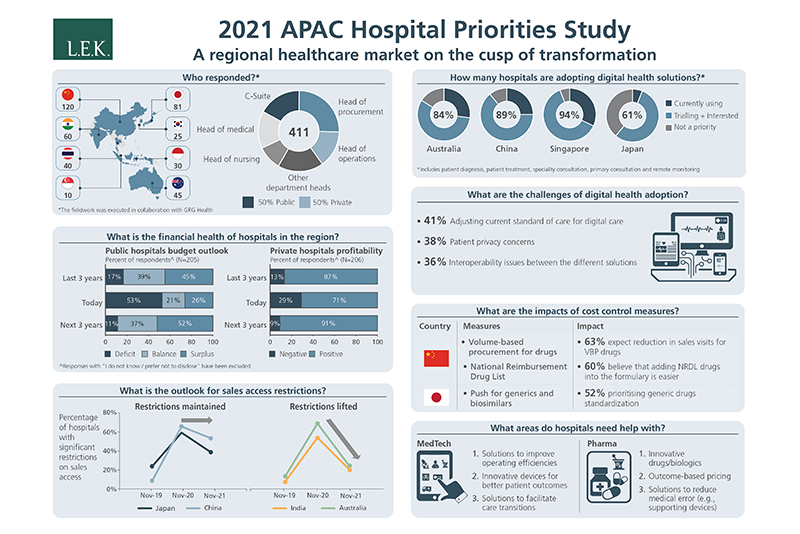
Healthcare in the Post-Covid World
The pandemic is proving to be a catalyst for innovation in the region’s healthcare sector.
The COVID-19 pandemic has upended businesses and industries around the world. One key sector that has been affected is the healthcare sector, which has witnessed the accelerated adoption of digitalisation.
L.E.K. Consulting, a global strategy consulting firm, recently conducted the 2021 APAC Hospital Priority Survey, in collaboration with GRG Health. The survey, which aims to shed light on the rapidly changing landscape in which hospitals operate, provides insights into how industry players across Asia Pacific (APAC), including Singapore, have adapted to the impact of the COVID-19 pandemic and how this has shaped their priorities for the future.
Fabio La Mola, Executive Director of L.E.K.’s Asia-Pacific Life Sciences Centre of Excellence, shares his views with BiZQ on the healthcare trends emerging in the region.

What are some of the key trends in healthcare in the APAC region?
The nature of COVID-19, with its restrictions on patient mobility and associated risk aversion to hospitals, has led to an increased acceptance of digital healthcare solutions for all stakeholders across APAC. As such, we are seeing a rapid digitalisation of various healthcare-related processes. For instance, as the risk of virus transmission has kept people away from hospitals, digital alternatives such as teleconsultation have become more common.
There have also been more opportunities for medtech and pharmaceutical companies to collaborate with hospitals in developing products and services that address current key concerns. Medical devices, for example, are being digitised in collaboration with hospitals in a much faster rate than would otherwise be the case. This clearly shows that the COVID-19 has played a pivotal role as a catalyst for the industry to look at digitalisation in a much more concerted manner.
The pandemic has also exposed some of the weaknesses in the healthcare system, revealing a clear need for new approaches to healthcare. All governments in APAC are making significant additional investments in healthcare, with budgets that extend beyond 2021. The most notable change because of these investments is that many governments are considering expanding healthcare delivery beyond hospitals and into community centers, including through digital means.

How has COVID-19 accelerated the prioritising of digital solutions and innovation in healthcare?
Fundamentally, digital solutions were spurred by the fact that people were unable to get to the hospital – whether it was due to mandatory lockdown measures or personal risk-aversion. The COVID-19 period saw a downturn in elective surgeries and outpatient consultations for hospitals across APAC. As a result, the digital realm became a means of staying in touch with these patients to provide some level of care during the pandemic that would otherwise have been difficult to provide. It has allowed hospitals to monitor these patients to a larger extent than was previously possible due to the high volume of COVID-19 patients.
Furthermore, a significant amount of training was required for hospital staff and doctors to go digital as a measure to contain the spread of the pandemic. Doctors also needed a way to continuously upgrade their knowledge and skills but were unable to do so through physical training, and medtech and digital training came into play to address this need.
The fact that there was a clear need for new approaches to COVID-19, both therapeutically and as a vaccine, has primarily driven medical innovation. Companies in APAC and outside of APAC, for example, introduced treatments and vaccine approaches through digital innovations. Vaccines that would have taken 10 years of research are now being developed and tested under the span of a year, which is an incredible timeline for an industry where development takes at least five to six years.
With multiple health solutions across different platforms, how can healthcare providers ensure interoperability to provide patients with a seamless experience?
This is still a work in progress. Several digital health companies are currently developing their own solutions. The current systems do not necessarily “talk” to each other well – with each storing and capturing data in different ways.
Nonetheless, I think that existing technology is generally much better than it was previously – there are interoperable systems, specifically APIs, that have been used in the healthcare industry. However, we are not yet at the point where the patient’s experience is seamless. A streamlined handover system between digital and other means has yet to be developed, but digital healthcare companies and hospitals are working hard to reduce patient friction. This is still a work in progress, but given current healthcare trends, I believe it will happen soon.
Patient privacy is another issue that has gained traction over the years. The ability to maintain records safely and prevent cybersecurity breaches remains a major concern for the industry, which deals with highly sensitive data. Trying to find the right balance between patient privacy and providing a seamless experience has proven to be more challenging than in other industries. Instead of responding to cybersecurity issues only when they occur, digital health companies must focus on real-time prevention.
How can other countries look at Singapore, with our technology-driven approach in healthcare, to better assess the viability of digital health solutions?
As a technologically advanced nation with a contained economy, Singapore has seen a proliferation of digital health solutions. There is also a specific programme from the National Science Foundation to finance some of these startups to support patients and deliver patient care beyond the physical premises of hospitals.
Medtech and pharmaceutical companies have been using Singapore as a test bed for some of their digital health solutions. For example, we have seen the use of digital health technologies in Singapore to remotely monitor COVID-19 patients living in foreign worker dormitories. We have also seen examples of apps, like COVID Buddy, that allow healthcare workers to remotely support COVID-19 patients. There are also other apps that are currently in development that will allow you to take medical examinations and answer questionnaires online before heading to the clinic, hence reducing waiting time.
Furthermore, because Singapore serves as a regional headquarters for many of these medtech companies, there are many opportunities for these large companies to trial solutions here. This has led Singapore to digitalise at a pace faster than other countries.


















